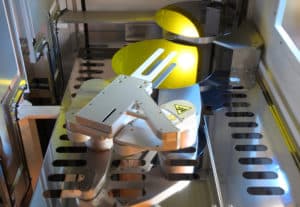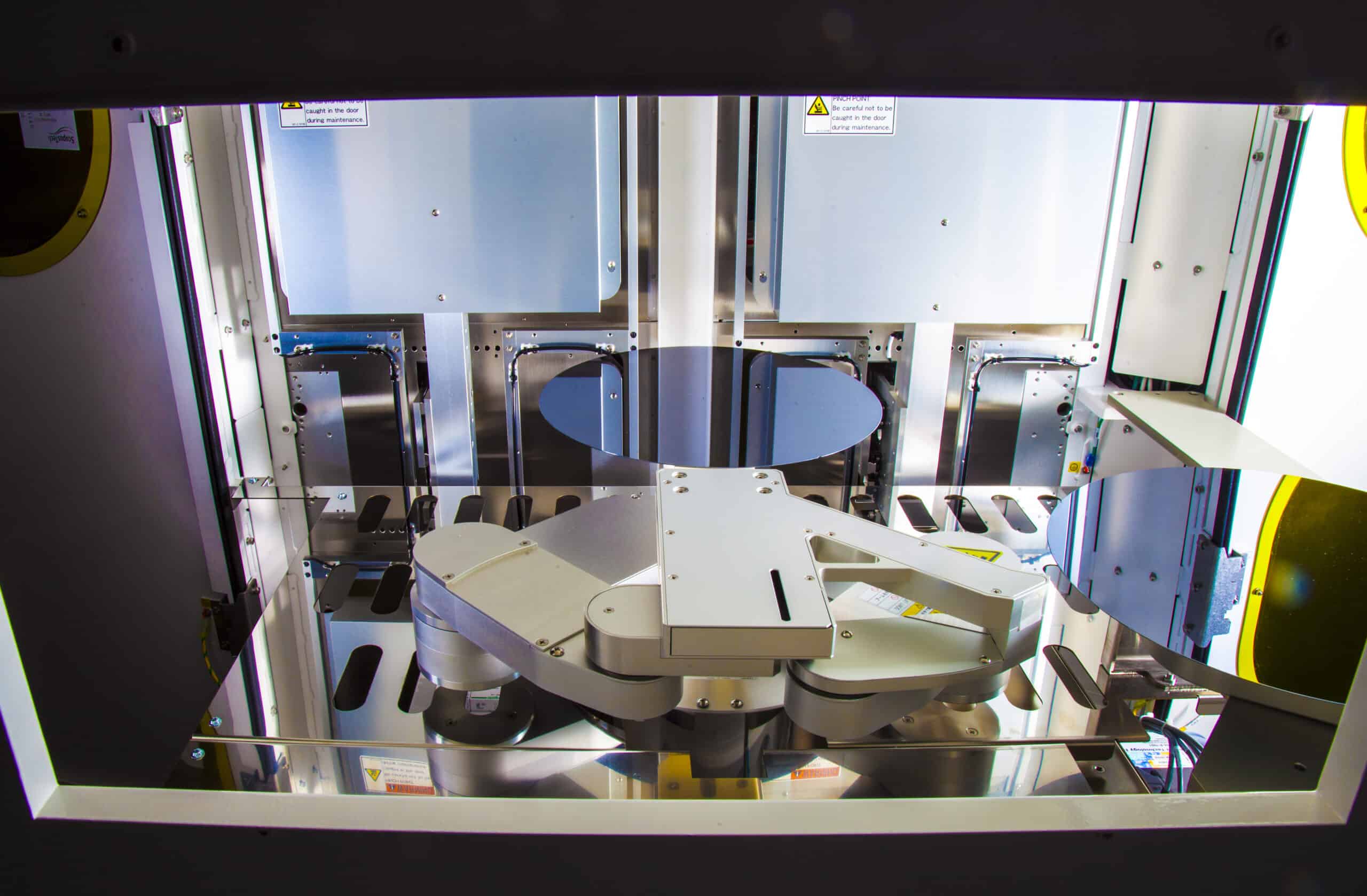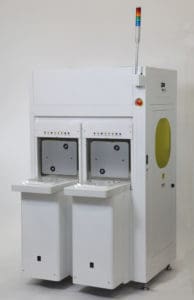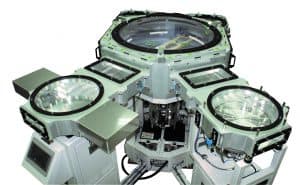The semiconductor industry is going through a dramatic expansion phase. Supply chain shortages, drastic rise in demand, and geo-political tensions have all fueled a race to build more advanced foundries around the world, in Europe the US and the far east. These new fabs are built from the ground up with state-of-the-art equipment. A typical fab includes hundreds of machines that perform a variety of processes to different type of wafers (Silicon, Glass, etc.). From deposition, material removal, patterning, modification of electrical properties, and more. A common element across all these machines is the need for wafer handling robots.
Designed to automate and facilitate the handling of silicon wafers during the semiconductor manufacturing process, these wafer handlers are integrated with semiconductor process tools which perform various manufacturing tasks throughout the semiconductor production lifecycle. But not all wafer handling systems are alike. There are various types of wafer handling robots, each type is designed to perform different types of tasks, in different environments, with different precision levels, etc. To help understand this world and how to find the right solution for every need, we have put together a rough mapping of the types of robots and the key factors that come into play when choosing the best solution that will meet the desired OEM tool automation needs.
Specific components vs. a full solution (EFEM, FI, Mini Environment)
Every wafer processing phase has different wafer handling needs, however typically a wafer handler along with a pattern recognition software should be able to remove a wafer from a cassette, place it onto a processing unit, such as probe station chuck, auto-align the wafer to the probes, wait for the probe station to complete its testing, and returning it to the cassette. This process involves the robot itself but also requires additional components, including:
- FFU (Fan Filter Units) for air flow management
- Load port / SMIF / Open Cassette loader
- Controller
- OCR
- RFID readers
- Pre-aligner
- Ionizers
All these components are orchestrated by software. Some semiconductor process tool manufacturers prefer purchasing different components and then integrating these components to form a full wafer handling solution within their product. Others prefer purchasing a full solution that has been fully integrated and tested by the manufacturer.
Since these solutions require a lot of customizations, not all tool automation manufacturers provide a full solution. Yaskawa as a global leader and manufacturer of Automation solutions offers both options, like very few other companies in this field. These companies have established the required engineering capabilities with proximity to the market, who are able to provide extensive customizations and design a full solution that is customized according to the client's specifications.
Precision
In a sub-micron industry, precision is probably the most important factor. High-end wafer handlers offer very high level of precision. To compensate for the lack of precision, low-end manufacturers sometimes use electro-optic components to adjust the position after the wafer has been placed in position. Although these adjustments can work sometimes, they still consume more time (the time it takes to adjust after the placement) and of course you would need to factor in the cost of the expensive optic components. But not all processes require high precision levels. For example, wet bench machines, which are used to carry out wet cleaning operations, don't require high precision at all. For these cases other factors should be taken into consideration.

Throughput
Just like in any other industry the throughput of a machine directly affects the performance of the specific machine as well as the performance of the full manufacturing line. The more throughput a machine can yield, the more processed wafers can move to the next station. Of course, the actual final throughput rate is very much dependent on all the components used in the chain, including the throughput of the processing itself. But you would not want the throughput of the wafer handler to be lower than the processing throughput. Within the wafer handler, the throughput can be influenced by a variety of factors, such as the substrate to be transported, the end effector used, and the size of the robot, to name a few. The full solution provider takes care of all these elements for best results.
Reach
Reach is a "technical" factor, but it is often considered as a "go/no-go"/qualifying factor. For the designers of the processing machine, if the arm of the wafer handler cannot reach the desired distance, it will not matter how precise it is, or its throughput levels, there is no way it can be used. And in many cases this factor cannot be customized or solved with other means.
Payload
Although a semiconductor wafer weighs only up to 200 grams, in some cases the wafer handler is required to handle heavier payloads. In cases like when a special substrate is used, e.g.: thick wafers, double wafers, ring frames, reticules, special tray, heavier payload is needed. There are some special robots that can handle the needed payload.
Weight and footprint
The wafer handler needs to fit into the processing machine design. And since a fab is an ultra-expensive facility, the allocation of space is limited. So, very often these limitations restrict the weight of the machine and its size. This is once more a "technical" factor that becomes a prerequisite even before considering the quality and performance of the solution.
Robots' reliability and maintenance
High reliability reduces the need for ongoing maintenance, while maintaining high level performance for longer periods of time. To improve reliability, wafer handling system manufacturers add innovative technologies to reduce the need for ongoing maintenance. For example, Yaskawa's new robots product line feature ∑7 engines, which do not require regular maintenance as they do not include batteries or tension belts.
Atmospheric systems vs. vacuum systems
Another qualifying factor is the environment in which the robot operates in. The manufacturing of semi-conductor devices in the semiconductor front-end industry requires a cleanroom environment, in which humidity, temperature and particle contamination are monitored and controlled within specified parameters.
Atmospheric cleanroom robots address several aspects, including suitable materials, clean drive trains and surface finishes. Specific materials are chosen for cleanroom wafer handlers that will reduce particle contamination from contact, friction, and out-gassing. These include materials for parts and components, coatings, lubricants, and material surfaces.
Some semiconductor manufacturing processes require an ultra-clean vacuum environment or a controlled environment of a gas mixture. The vacuum environments vary between low-vacuum and high vacuum environments.
In many cases the robot arm is in vacuum, while the robot base resides in ambient atmosphere. Motion generated by motors in the robot base is transferred across a dynamic vacuum barrier into vacuum to control the arm. The barrier provides the required vacuum integrity.
In addition to the special materials and constraints of vacuum environments, such as vacuum-compliant lubricants, magnetic feedthroughs, bellows, magnetic couplings, motors with integrated vacuum barrier, etc., one of the most critical factors when considering a vacuum wafer handler system, is the extremely low maintenance aspect. Since there is no human access to the robot for maintenance, the solution should be carefully designed so that it will offer extremely high MTBF/MTTR rates. This means, for example, minimizing the number parts that would require maintenance such as backup batteries, tension belts, etc.
Conclusion
In conclusion, as we've seen, choosing the right wafer handling solution for your needs requires careful examination of your technical qualifying prerequisites such as reach, weight and footprint, payload etc. After these are met you should consider other factors such as the throughput, the reliability, and the precision. Some processes such as wet bench machines are less demanding than others and can allow you to consider a wider range of alternatives. But when it comes to vacuum systems you should always strive for the most reliable solutions with extremely high MTBF/MTTR rates.




